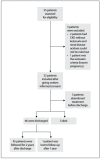Incidence, characteristics and long-term outcomes of patients with diabetic ketoacidosis: a prospective prognosis cohort study in an emergency department
- PMID: 33656122
- PMCID: PMC9632496
- DOI: 10.1590/1516-3180.2020.0285.R1.21102020
Incidence, characteristics and long-term outcomes of patients with diabetic ketoacidosis: a prospective prognosis cohort study in an emergency department
Abstract
Background: Diabetic ketoacidosis is the most frequent hyperglycemic complication in the evolution of diabetes mellitus. Common precipitating factors include newly diagnosed diabetes mellitus, noncompliance with therapy and infections. However, few studies have been conducted in Brazil and none were prospective in design.
Objective: To describe the incidence, clinical and laboratory characteristics and precipitating factors of diabetic ketoacidosis among emergency department patients in a tertiary-level teaching hospital in Brazil. We also aimed to identify immediate and long-term mortality within two years.
Design and setting: Prospective prognosis cohort study conduct at a tertiary-level teaching hospital in São Paulo, Brazil.
Methods: All patients > 12 years old presenting diabetic ketoacidosis who were admitted to the emergency department from June 2015 to May 2016 were invited to participate.
Results: The incidence of diabetic ketoacidosis per 1,000 admissions was 8.7. Treatment noncompliance and infection were the most common causes of diabetic ketoacidosis. The immediate mortality rate was 5.8%, while the six-month, one-year and two-year mortality rates were 9.6%, 13.5% and 19.2%, respectively. Death occurring within two years was associated with age, type 2 diabetes, hypoalbuminemia, infection at presentation and higher sequential organ failure assessment (SOFA) score at admission.
Conclusions: Diabetic ketoacidosis among patients presenting to the emergency department was relatively frequent in our hospital. Treatment noncompliance and infection were major precipitating factors and presence of diabetic ketoacidosis was associated with immediate and long-term risk of death.
Conflict of interest statement
Figures
References
MeSH terms
LinkOut - more resources
Full Text Sources
Other Literature Sources
Medical




